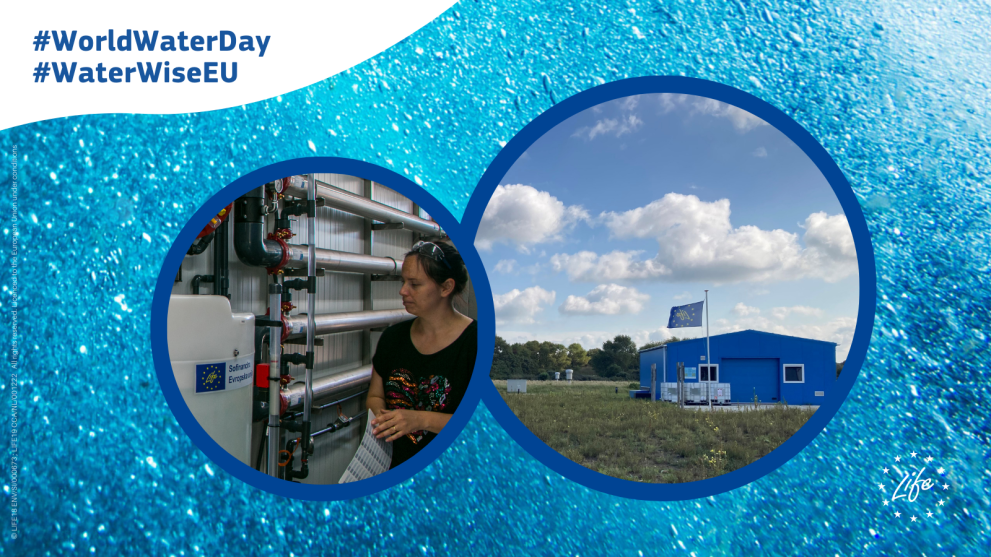
Europe is the fastest warming continent in the world. Over recent years, EU citizens have experienced droughts, flooding, heatwaves, and wildfires, more frequently and ferociously. To mark the UN World Water Day today, we highlight three LIFE projects tackling water resilience.
Europe’s second-longest river, the Danube, flows through 10 countries, from Germany to the Black Sea. In the German town of Donauwörth, flood alleviation measures have impacted biodiversity, groundwater levels, drinking water supply, agriculture, human health, and habitats for flora and fauna, often negatively. LIFE CityRiver is taking a new approach to fix this, by stabilising the riverbed in a variety of ways, and building a relationship between citizens and their river. A 1 km breach ramp is protecting 60 000m2 of riverbed, providing good passage for fish, near-natural river structures, 800m of spawning areas, and key habitats. And crucially, local communities have a say in their river’s future and prosperity through engagement, and the protection of their riverside spaces, buildings, and bridges. LIFE CityRiver will share successes and lessons learnt to influence other river communities across Europe.
Further north, the Dutch coastal sand dunes could seem an unusual location for sourcing water. Nevertheless, freshwater has been extracted from these habitats since the 1950s via a managed aquifer recharge system. Climate change is threatening this source through sea-level rises and increased water salinity, and the Dutch water company Dunea needed another solution. LIFE FRESHMAN looks at another source – brackish water, in the same sand dunes, which is then treated for drinking. By hydraulically manipulating the distribution of fresh, brackish, and saline groundwater, the project is increasing the stock of local freshwater, as well as desalinating brackish water. Its main objective is to prove that brackish groundwater is a suitable drinking water source. Through this process at the pilot site Meijendel in the Netherlands, LIFE FRESHMAN will provide 88 000m3 of additional drinking water a year – equal to the drinking needs of almost 2000 persons per year. This concept is being trialled until 2025, with results shared with other coastal areas.
From the banks of the Danube to the North Sea, to an automotive factory in Slovenia, LIFE projects are varied in their searches for water sources. At a Hidria factory – one of Slovenia’s largest automotive corporations – LIFE HIDAQUA is recycling industrial wastewater. This is polluted with minerals, grease, and oils which are not effectively removed by conventional wastewater treatments. By applying zero-liquid-discharge and zero-waste concepts, LIFE HIDAQUA is producing an alternative water supply through rainwater harvesting and using recycled and brackish water. Around 4 000m3 of wastewater is being treated annually on site. The project is expected to produce around 8 000m3 of drinking water a year – just over the drinking needs of an average family for 3 years. Around 1.5 tonnes of residue from treating wastewater, such as salt and building composites, will be sent to the construction sector. Speaking about LIFE HIDAQUA, “innovative water management isn't just a necessity; it's the gateway towards the greener and more sustainable tomorrow," said Dr. Sara Seršen, Project Manager at LIFE HIDAQUA.
In celebration of World Water Day, a new campaign, #WaterWiseEU, is being launched by the European Commission’s Directorate-General for the Environment on 22 March. Aiming to raise awareness of the increasing stress placed on Europe’s water systems, it encourages citizens and stakeholders to work together to see, manage and consume water differently. A toolkit will be published on 8 April for interested parties to adapt events and campaign activities to local settings, ready for launch as part of EU Green Week 2024 starting on 29 May.
Water resilience in the EU is also the key focus of EU Green Week 2024. Speakers will discuss fostering a water smart economy, the challenges of restoring the EU’s water cycle, access to clean and affordable water sources, and sanitation. Green Week Conference registration will open in April.
More information:
The three projects mentioned in the article align to a number of EU policies including the Floods Directive; Circular Economy Action Plan; Water Framework Directive; Marine Strategy Framework Directive; Habitats Directive; Biodiversity Strategy for 2030; A Roadmap for moving to a competitive low carbon economy in 2050; and Waste Framework Directive.
Details
- Publication date
- 22 March 2024
- Author
- European Climate, Infrastructure and Environment Executive Agency

